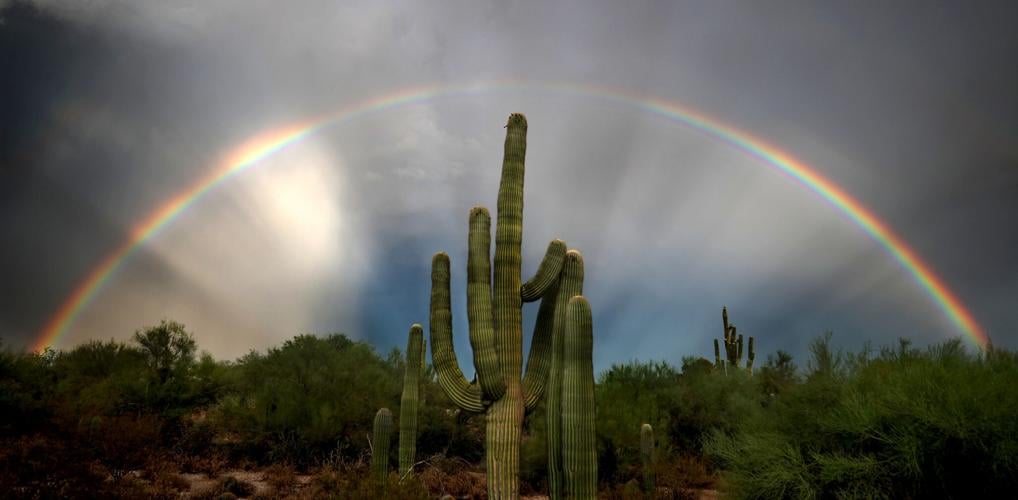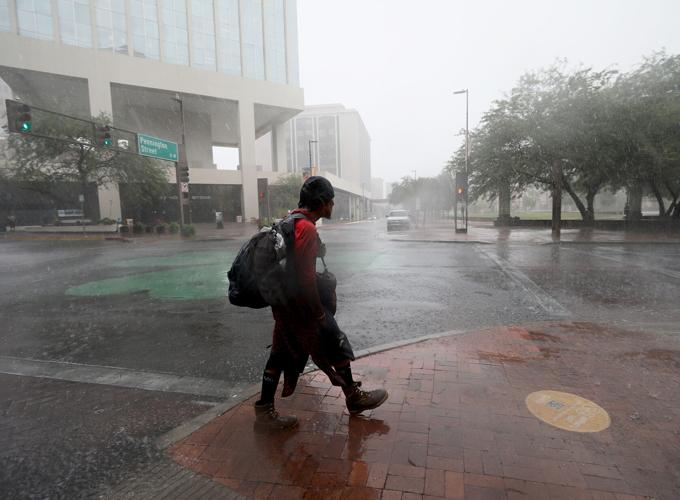After an unusually wet winter, Tucsonans should prepare for another hot and drier than average summer, data provided by the National Weather Service and the Climate Prediction Center suggests.
There’s a 4-in-10 chance of a drier-than-normal summer here, the National Weather Service said in its new 2024 Monsoon Outlook released this week, predicting that 2024 will be yet another dry monsoon season.
“Our average monsoon rainfall in Tucson specifically is 5.69 inches, on average,” said Meteorologist Dalton Van Stratten. “We’ll likely see below that 5.69-inch threshold.”
Last year was the 17th-driest monsoon across Arizona since 1895, according to the National Weather Service 2024 Monsoon Outlook. Tucson received only 4.73 inches of rain in 2023 or .96 inches less than average, National Weather Service records show.
Nearly 40% of the state, including Tucson and Phoenix, is expected to receive below-normal precipitation during the summer’s monsoon season.

A rainbow arcs over the eastern sky behind a stand of saguaros along north Campbell Avenue, part of the scattered monsoon storm that rumbled over Tucson, Aug. 8, 2023.
“Let me just first start off by saying that forecasting the monsoon is incredibly hard,” said Michael Crimmins, a professor and climate science specialist in the University of Arizona’s Department of Soil, Water and Environmental Science.
Crimmins and the team at The Climate Assessment for the Southwest (CLIMAS) utilize data from numerous forecast models from across the world to try to determine weather and climate patterns, and despite the imprecise nature of monsoon forecasts, Crimmins said there is a common consensus.
“July, August, and September precipitation totals across many of the models have been below average,” Crimmins said.
A below-average monsoon season could be the result of a possible La Niña weather pattern, according to Van Stratten and the National Weather Service.
As explained by Crimmins, La Niña and El Nino are two different phases of the El Nino Southern Oscillation, a large-scale temperature pattern which oscillates between warm and cold in the eastern and western parts of the Pacific Ocean along the equator.
The National Weather Service currently predicts a 70% chance of a La Niña event this summer, which could mean less Pacific Tropical Cyclone activity.
“That usually means that we see drier conditions over the desert southwest as well,” Van Stratten said.
Crimmins however, disagreed
“It’s still kind of up in the air, but the summer impact of La Niña on the monsoon is actually quite weak,” Crimmins said.
Another potential factor that could contribute to a below-average monsoon season, according to the National Weather Service Outlook is the above average soil moisture across Arizona.
“Since January 1, we’ve had 5.29 inches of rain and normally we see 2.68, so we are 2.61 inches above normal rainfall,” Van Stratten said.
All that rain has cooled and saturated the ground surface, slowing the heating that is needed to intensify the overall weather patterns and bring the monsoons.
“As the ground and atmosphere warms, we get a reversal in the winds that leads to monsoon season,” Van Stratten said. “Without that intense heating, we don’t see a strong reversal of that wind pattern.”
Coupled with a dry monsoon season, the National Weather Service is also predicting a 6-in-10 chance of a hotter-than-normal summer.
“It’s not uncommon to see 100 degree temps,” Van Stratten said. “We might even see higher than that.”
Arizona receives between 30% and 60% of its yearly precipitation during the monsoons from mid-June through the end of September, but facing another blisteringly hot, dry summer, with little relief from the monsoon rains, experts are bracing for an increased number of wildfires across the state, according to the National Weather Service.
“We are already starting to see significant fire activity in certain areas,” said Tiffany Davila, a spokeswoman for the Arizona Department of Forestry and Fire Management.
“We’re at 30,000-plus acres burned so far this year, compared to last year in the same timeframe about 10,000 acres burned,” Davila said.

A man walks at the intersection of Stone Ave. and Pennington Street as a monsoon storm passes over downtown Tucson on Aug. 21, 2023.
The Coronado National Forest has also begun to see outbreaks of small, manageable fires in early 2024, said Starr Farrell, an agency spokeswoman.
“Our forest is on high alert right now,” Farrell said.
According to both Farrell and Davila, the early moisture and abnormally wet winter conditions have resulted in considerable vegetation growth, which significantly increases the chance for wildfires as the grass and brush dries out. Davilia said that in some areas, the fuel load has increased as much as 200%.
“If we have that increase, and there is a fire that starts, that’s now a fuel, or a way for that fire to travel across the landscape,” Farrell said.
As of right now, Farrell said there are no fire restrictions within Coronado National Forest but that their fire management teams will continue to monitor the situation closely and use the expertise of the National Weather Service to inform their operations.
In preparation for the monsoon season, starting June 9th, The National Weather Service will begin a Monsoon Awareness week with daily topics like Extreme Heat, Downburst Winds and Recreating During the Monsoon.
“It’s just increasing awareness,” said Meteorologist Tom Dang. “There will be videos talking about the outlook, preparedness, planning type activities that people can do, and then just like general statistics.”
After an active evening of thunderstorms on July 31, southeastern Arizona will see less monsoon activity later in the week, according to the National Weather Service.
Video courtesy of the University of Arizona Department of Hydrology and Atmospheric Sciences.





